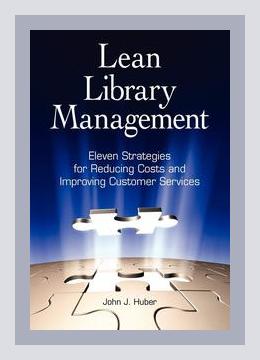Entrepreneurship and StartupsLean Startups
Introduction
John J. Huber’s “Lean Library Management” offers comprehensive guidance on applying Lean principles—rooted in Lean Startup methodologies—to library management. Huber’s approach focuses on creating efficient, user-centered libraries by reducing waste, optimizing workflows, and improving services. The book is structured around actionable strategies that library managers can implement to enhance operational efficiency and user satisfaction.
Key Concepts
Lean Principles in Libraries
Huber introduces the concept of Lean thinking, a methodology borne from Toyota’s production system, which emphasizes efficiency, waste reduction, and continuous improvement. He applies these principles to library management to help libraries adapt to changing user needs and financial constraints.
Actionable Step: Familiarize yourself with the basic concepts of Lean, including value stream mapping, Kaizen (continuous improvement), and the 5S methodology (Sort, Set in order, Shine, Standardize, Sustain). Begin by reading foundational texts on Lean practices.
Value Stream Mapping (VSM)
Value Stream Mapping is crucial for visualizing library processes and identifying inefficiencies. Huber illustrates this with a library’s acquisition process, where VSM helps pinpoint bottlenecks like slow procurement or lengthy cataloging times.
Actionable Step: Create a value stream map of a core library process, such as acquiring new materials. Identify each step from ordering to shelving and analyze where delays or redundancies exist.
Waste Identification
Huber categorizes waste into seven types: overproduction, waiting, unnecessary transport, extra processing, inventory, motion, and defects. He provides examples from libraries, such as overstaffing during slow hours or stocking rarely used materials.
Actionable Step: Conduct a waste audit in your library. List activities and categorize them into the seven types of waste. Develop strategies to eliminate or reduce these inefficiencies.
Customer Focus
A central tenet of Lean is prioritizing the end user. Huber underscores the importance of understanding library patrons’ needs and preferences, using surveys, focus groups, and usage data.
Actionable Step: Implement regular patron surveys and feedback mechanisms. Use this data to inform decision-making about collections, space utilization, and services offered.
Strategies and Examples
Streamlining Acquisitions
Huber describes how one library cut its acquisition time from months to weeks by simplifying supplier contracts and adopting electronic ordering systems. This resulted in faster access to new materials for patrons.
Actionable Step: Review and optimize your procurement processes. Consider consolidating vendor contracts and implementing electronic procurement systems to streamline this workflow.
Efficient Space Utilization
Many libraries face space constraints. Huber advises libraries to use Lean principles to maximize space efficiency, citing an example where a library reconfigured its layout to create additional study areas without reducing shelf space.
Actionable Step: Analyze your library’s floor plan and usage patterns. Use space more effectively by removing or repurposing underutilized areas. Engage staff and patrons in the redesign process to ensure it meets users’ needs.
Improving Circulation Processes
Huber recounts how a library reduced book return processing times by rearranging workspaces and deploying automated sorting systems. This increased efficiency and reduced error rates.
Actionable Step: Evaluate your circulation desk and back-end processes. Invest in technology like RFID tags or automated sorting machines to streamline operations. Ensure staff are well-trained in new procedures.
Enhancing Staff Productivity
Staff efficiency is central to Lean Library Management. Huber talks about cross-training staff to handle multiple roles, which reduces downtime and increases adaptability during peak periods.
Actionable Step: Develop a cross-training program for your library staff. Encourage flexibility and skill-sharing so that employees can support different functions as needed.
Fostering Team Collaboration
Huber highlights the importance of collaborative problem-solving, using Kaizen events—focused improvement projects—to tackle specific issues. He shares a case where a library team reduced the time taken for book repairs by 50%.
Actionable Step: Organize regular Kaizen events to address specific process improvements. Involve staff from different areas to bring diverse perspectives and foster a team-driven approach to problem-solving.
Long-Term Implementation
Sustaining Lean Practices
Long-term success in Lean implementation requires a commitment to continuous improvement. Huber notes that some libraries incorporate Lean thinking into their culture by regularly reviewing processes and celebrating incremental improvements.
Actionable Step: Establish a continuous improvement program. Schedule regular review meetings to assess progress and identify new opportunities for efficiency gains. Celebrate successes—even small ones—to maintain momentum.
Adapting to Change
Libraries must be agile to respond to technological advancements and changing user needs. Huber discusses how one library stayed relevant by continuously updating its digital resources and services based on user feedback.
Actionable Step: Create a responsive plan for technology adoption and service updates. Regularly review and adjust your offerings based on patron usage data and emerging trends.
Leadership and Vision
Lean Library Management requires strong leadership committed to fostering a culture of efficiency and user-centered service. Huber illustrates this through leaders who champion Lean principles and inspire staff to embrace change.
Actionable Step: As a library manager, lead by example. Educate yourself on Lean principles and communicate their benefits to your team. Provide training and resources to support staff in adopting these practices.
Benchmarking Progress
Huber emphasizes the importance of setting benchmarks and tracking performance improvements. He provides examples of libraries that use metrics like turnaround times, patron satisfaction scores, and cost savings to measure success.
Actionable Step: Develop a set of Key Performance Indicators (KPIs) to track your library’s Lean implementation progress. Regularly review these metrics and adjust strategies as necessary to continue improving.
Conclusion
“Lean Library Management” by John J. Huber offers a detailed roadmap for transforming libraries into efficient, user-focused organizations. By applying Lean principles, libraries can reduce waste, optimize workflows, and continuously improve to meet the evolving needs of their communities. With actionable steps provided for each strategy, library managers can begin implementing Lean practices to achieve significant operational improvements and enhance the overall library experience for patrons.
